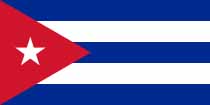 |
Number of versions: 1
Edition: October 11, 2008
|

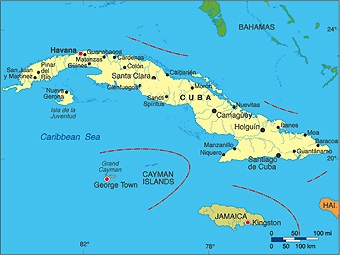
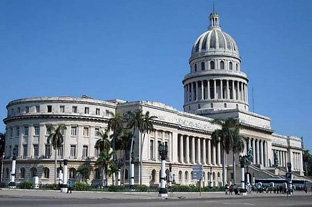
The monumental building in Cuba's capital city Havana El Capitolio,
served as the seat of the legislature from Februari 1931 until the late 1950s;
both the House of Representatives and Senate were based in the building.
Under Fidel Castro's regime, since Febr. 1959, it became home to the
Ministry of Science, Technology and the Environment.
It is Dan Glimne from Sweden who succeeded in finding an exceptional
Monopoly edition during his stay in Cuba, November 2007.
This is what he tells about it:
"Who published this
Monopoly rip-off is still a mystery to me, as there is no manufacturer mentioned
anywhere on the board or on the cards. In all likelihood the manufacturer was a
local printer, and who was well aware that it was a rip-off: thus no name,
making the game harder to trace back to the printer. From what I could gather in
Cuba, the game was not likely published in the 1940's, but instead from around
1950 or so onwards; although the older people I talked to were very unsure after
over half a century. The game abruptly ceased to be published in 1959, however,
when Fidel Castro and his band seized power and quickly banned the game, plus as
many other US influences as possible, including Coca-Cola etc. Also, every
casino on the island was immediately closed overnight. The game has not been
published since, as Cuba is still under communist rule, but underground
pre-revolution copies are of course floating around. While in Havanna for three
days in November 2007, my two goals were to obtain an ékuelé (another story,
but games-related) and a Capitolio game. After making furtive inquiries about
Capitolio in several market places, I was told in one to come back at a certain
time the next day, to a certain stall, and there they had one for me: complete,
although a bit worn and with a slightly soiled board. The whole transaction took
place while we all watched out for the ubiquitous police: a bit of a strange way
to buy a Monopoly game, I must say...
Whether or not an "official" and
competing Parker Brothers version was published in Cuba during the 1950's I do
not know, but I have not seen or heard of any evidence for this. My guess is
that Capitolio is/was the only truly Cuban version of the game ever published,
so far."
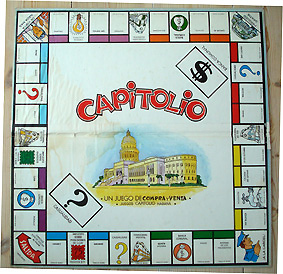 Edition:
Capitolio Edition:
Capitolio
*
Un juego de compra y venta * (A game of
buying and sale)
Publisher: * Juegos CAPITOLIO Habana * (= ficticious name
of inland manufacturer?) - before 1959
Dimensions of the board: 49.0 x 49.5 cm
of the tin: 13.0 x 7.9 x 9.0 cm
The game:
This unique pre-Fidel era edition looks very much like a Parker Bros. edition but at
closer study it clearly shows that everything has been done to wriggle out of
Parker Bros.' copyright. Except from its name already clear examples of the
differences are f.e.:
 | The word Capitolio (not in a frame but
red anyhow!) and the image are not on
top the first side but the fourth one. |
 | The man in Jail is a well dressed gentleman in a suit and with tie,
looking from behind 4 bars. |
 | The car on the Parqueo Gratis is a big passenger car with license
plate number 1995 (meaning ?) seen from the front,
instead of the well-known little red car
with white tires, seen from the back. |
 | The policeman on the ¡A la Carcel! corner is a somewhat frightened
looking man in blue uniform but without
whistle. |
 | The images on the stations spaces show an impressive, heavy
locomotive in different colors instead of the black Parker
engine. |
On the other hand it is striking that the color groups of the streets
have the same colors, in the same order and even for sale at the same prices,
while the Casualidad (toeval) cards stack is next to the Salida
corner as with the Parker editions.
From Salida onwards all properties are streets
of Havanna:
Muralla - Banca Comunal (Community
Chest) - Cuba - Impuesto sobre
ingresos (Income Tax) - Ferrocarril
(yellow line)
- 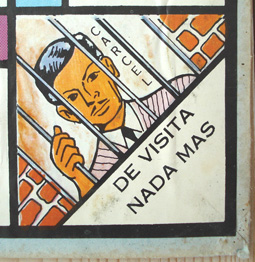 Aguila - Casualidad - Monte
- Reina - Cárcel - Galeano
- Empresa Electrica - San Rafael - Neptuno
- Ferrocarril Occidental (green line)
- Belascoain - Banca Comunal - Infanta
- Carlos III - Parqueo Gratis - San
Lazaro - Casualidad - Malecon - Prado
- Ferrocarril del Sur (light blue line)
- 10 de octubre
- Calzada de
Luyano - Acueducto - Via
Blanca - ¡A la Cárcel! - Avenida
de los presidentes - Paseo -
Banca Comunal - Quinta avenida - Ferrocarril
Oriental (brown line) - Casualidad - Miramar
- Impuesto sobre posesiones lujo (luxury tax) and Siboney. Aguila - Casualidad - Monte
- Reina - Cárcel - Galeano
- Empresa Electrica - San Rafael - Neptuno
- Ferrocarril Occidental (green line)
- Belascoain - Banca Comunal - Infanta
- Carlos III - Parqueo Gratis - San
Lazaro - Casualidad - Malecon - Prado
- Ferrocarril del Sur (light blue line)
- 10 de octubre
- Calzada de
Luyano - Acueducto - Via
Blanca - ¡A la Cárcel! - Avenida
de los presidentes - Paseo -
Banca Comunal - Quinta avenida - Ferrocarril
Oriental (brown line) - Casualidad - Miramar
- Impuesto sobre posesiones lujo (luxury tax) and Siboney.
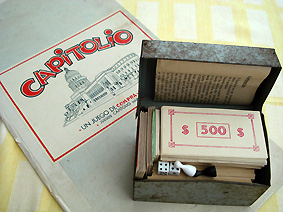 The
game board is of solid cardboard, both sides light
blue with a white logo sticker on the back side. The entire
contents of the game came in a metal box. Whether this was
the original "packing" is not certain, but it is very likely, seeing how the game is so complete and
well-preserved when it comes to all
the cards and, considering that local printer probably took what he could
obtain, the stuff fits beatifully and very compactly. Judging from a square
darker marking on the top of the box, there probably was a sticker on it at one
time, but which has now been lost. The
game board is of solid cardboard, both sides light
blue with a white logo sticker on the back side. The entire
contents of the game came in a metal box. Whether this was
the original "packing" is not certain, but it is very likely, seeing how the game is so complete and
well-preserved when it comes to all
the cards and, considering that local printer probably took what he could
obtain, the stuff fits beatifully and very compactly. Judging from a square
darker marking on the top of the box, there probably was a sticker on it at one
time, but which has now been lost.
The property cards (76 x 64 mm) are made of
medium thick cardboard. Their front side is white and printed in black in
a frame of the same color of the bar of the property. They have very coarse brownish backs.
The Casualidad and Banca Comunal cards (70 x 51 mm) are made of thinner paper than usual for
such cards. Their backs are completely
blank. The instructions are illustrated in a somewhat simple way as these
samples show:
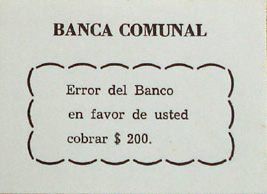 |
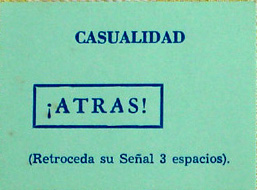 |
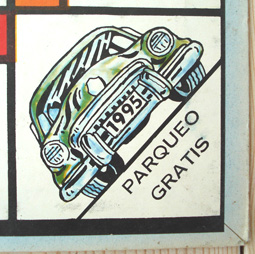 The banknotes (102x53 mm)
going with the game consist of 7 different
denominations, printed in color on fairly coarse white paper and slightly thicker than one would
expect: 1 - 5
- 10 - 20
- 50 - 100
and 500 $ (where the $-sign stands for Cuban
pre-revolution pesos). The banknotes (102x53 mm)
going with the game consist of 7 different
denominations, printed in color on fairly coarse white paper and slightly thicker than one would
expect: 1 - 5
- 10 - 20
- 50 - 100
and 500 $ (where the $-sign stands for Cuban
pre-revolution pesos).
There are only 4 pawn shaped tokens (23 mm high) of cheap, molded plastic
with this set: no doubt obtained from some
sort of standard local manufacture.
The Rules (see inside the lid)
comprise a total of 6 pages on 2 separate sheets: one measuring 32.8 x 21.6 cm, and one half of that:
16.4 x 21.6 cm. The smaller sheet is effectively pages 3 and 4, and folded inside the larger sheet.
The dice are also of cheap plastic, 11 mm square, with pips that appear to have been printed on rather than
handpainted. The sides of them are slightly concave.
|